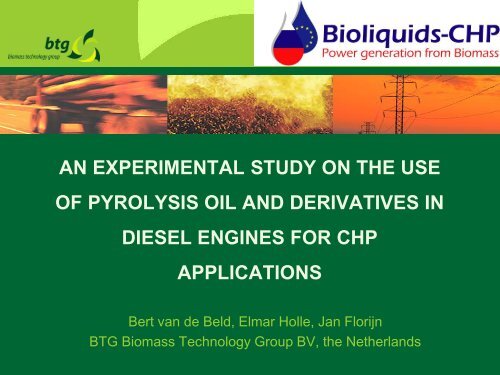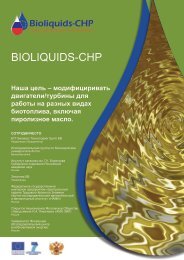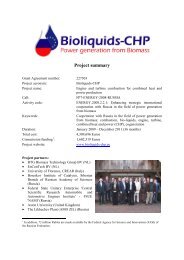BTG - Bert van de Beld - Bioliquids-CHP
BTG - Bert van de Beld - Bioliquids-CHP
BTG - Bert van de Beld - Bioliquids-CHP
You also want an ePaper? Increase the reach of your titles
YUMPU automatically turns print PDFs into web optimized ePapers that Google loves.
AN EXPERIMENTAL STUDY ON THE USE<br />
OF PYROLYSIS OIL AND DERIVATIVES IN<br />
DIESEL ENGINES FOR <strong>CHP</strong><br />
APPLICATIONS<br />
<strong>Bert</strong> <strong>van</strong> <strong>de</strong> <strong>Beld</strong>, Elmar Holle, Jan Florijn<br />
<strong>BTG</strong> Biomass Technology Group BV, the Netherlands
Content<br />
• Introduction & objectives<br />
• Engine test facility<br />
• Results<br />
• Summary<br />
sli<strong>de</strong> 2
sli<strong>de</strong> 3<br />
Introduction
Introduction & Objectives<br />
Main Objective <strong>BTG</strong><br />
Develop and <strong>de</strong>monstrate a cost-effective C(C)HP system based on<br />
conventional CI – engines and fuelled with pyrolysis oil or pyrolysis oil<br />
<strong>de</strong>rived liquids for a capacity range of 50 - 1,000 kW e .<br />
Specific <strong>BTG</strong> Activities<br />
‣ Chemical & physical treatment of pyrolysis oil to improve fuel<br />
characteristics;<br />
‣ Development of pyrolysis oil tolerant engine components;<br />
‣ Construction and testing of a modified CI – engine.<br />
sli<strong>de</strong> 4
Introduction<br />
‣ Oil is acidic: all piping/<strong>de</strong>vices in contact with<br />
pyrolysis oil must be corrosion resistant;<br />
Property<br />
Water content<br />
Solids content<br />
Value<br />
25,4<br />
0.04<br />
Unit<br />
wt%<br />
wt%<br />
‣ Oil contains water and small particles: severe<br />
abrasive wear is to be expected;<br />
‣ Viscosity of pyrolysis oil is higher than of fossil<br />
diesel;<br />
Density<br />
LHV<br />
pH<br />
MCRT<br />
Viscosity (40 °C)<br />
1,170<br />
16,1<br />
2.85<br />
15,1<br />
13,0<br />
kg/m 3<br />
MJ/kg<br />
-<br />
wt%<br />
cSt<br />
‣ Pyrolysis oil is sensitive to re-polymerisation above<br />
50-60 °C resulting in small particles and higher<br />
viscosities;<br />
‣ Pyrolyis oil is more difficult to ignite – Cetane<br />
Number is estimated to be in range of 10-25;<br />
‣ Heating value of pyrolysis oil is lower (approx. ½ of<br />
diesel fuel on volumetric basis)<br />
sli<strong>de</strong> 5
Compression Ignition<br />
(CI) Engine set-up<br />
sli<strong>de</strong> 6
CI - Engine test facility – basis<br />
Basis: JIANG DONG Engine<br />
Mo<strong>de</strong>l<br />
Piston displacement:<br />
Compression ratio:<br />
Output:<br />
Injection pressure:<br />
Fuel consumption:<br />
Generator output:<br />
ZH1130<br />
1-cylin<strong>de</strong>r<br />
1,592 ml<br />
17,6<br />
23,5 kW<br />
(2,200 rpm)<br />
200 – 250 bar<br />
240g/kW e (diesel)<br />
Max. 10 kW e<br />
sli<strong>de</strong> 7
CI - Engine test facility - Modifications<br />
Major modifications:<br />
‣ Corrosion resistant fuel injector<br />
‣ Corrosion resistant fuel pump<br />
‣ Air preheating<br />
‣ Fuel preheating<br />
‣ Adjustable fuel injection timing<br />
sli<strong>de</strong> 8
Test Fuel<br />
Rinse Fuel<br />
Diesel<br />
Waste<br />
Engine test set-up<br />
Variable load<br />
1 – 12 kWe<br />
Electricity<br />
Generator<br />
TI<br />
Gas analyzer<br />
Exhaust<br />
Air<br />
Smart<br />
Power<br />
Analyzer<br />
TIC<br />
TI<br />
JIANG DONG<br />
Diesel<br />
Engine<br />
Soot analyzer<br />
TI<br />
Cooling Water<br />
TI<br />
TI<br />
air<br />
Fuel<br />
pump<br />
TI<br />
Fuel<br />
injector<br />
PI<br />
TI<br />
PI<br />
TI<br />
TIC<br />
WI<br />
Schematic drawing of the engine test rig<br />
sli<strong>de</strong> 9
Engine test set-up<br />
Energy dissipation (1-12 kWe)<br />
Fuel feeding<br />
Engine set-up<br />
sli<strong>de</strong> 10
Engine test set-up - measurements<br />
Data aquisition & control<br />
Engine control & monitoring<br />
Injector pressure<br />
Gas composition & soot<br />
Power output monitoring<br />
sli<strong>de</strong> 11
sli<strong>de</strong> 12<br />
Results<br />
• Air preheat temperature<br />
• Fuel injection pressure<br />
• Fuel injection timing<br />
• Performance of different fuels<br />
• ‘Duration’ testing
Air preheat temperature<br />
CO emissions as a function of the air preheat temperature; Electrical load = 4<br />
kW e ; Fuel preheat temperature = 40-50 °C<br />
sli<strong>de</strong> 13
Fuel injection pressure<br />
Diesel engine operation with diesel and pyrolysis oil; electrical load = 3 kW e ; in both cases<br />
the new stainless steel injector is used<br />
sli<strong>de</strong> 14
Injection pressure [bar]<br />
Fuel injection pressure<br />
300<br />
280<br />
260<br />
Pyrolysis, stainless steel injector<br />
240<br />
220<br />
Pyrolysis, Standard injector<br />
200<br />
180<br />
Diesel, stainless steel injector<br />
160<br />
140<br />
Diesel, standard injector<br />
120<br />
100<br />
0 500 1000 1500 2000 2500 3000 3500 4000 4500 5000<br />
Runtime engine [s]<br />
Diesel engine operation with diesel and pyrolysis oil with a standard injector and<br />
a stainless steel injector; electrical load = 3 kWe<br />
sli<strong>de</strong> 15
Fuel injection timing<br />
CO emissions as a function of the fuel injection timing for different fuels;<br />
Electrical load = 4 kW e<br />
sli<strong>de</strong> 16
Different fuels<br />
NO x emissions for different fuels as<br />
a function of the electrical<br />
load;<br />
CO emissions for different fuels as<br />
a function of the electrical<br />
load;<br />
sli<strong>de</strong> 17
Duration test<br />
CO and NO x concentration in the flue gas as a function of the runtime;<br />
Fuel = pyrolysis oil; electrical load = 3 kW e ; Air inlet temperature =<br />
120 °C<br />
sli<strong>de</strong> 18
Duration test<br />
Fuel consumption [g/kW e ] as a function of the runtime; Fuel = pyrolysis<br />
oil; electrical load = 3 kW e ; Air inlet temperature = 120 °C<br />
sli<strong>de</strong> 19
sli<strong>de</strong> 20<br />
Summary
Summary<br />
‣ A conventional CI-engine has been modified to enable the fuelling of<br />
pyrolysis oil and pyrolysis oil <strong>de</strong>rivatives;<br />
‣ Major changes to the engine concern:<br />
‣ the fuel feeding and injection system – corrosion resistant<br />
material;<br />
‣ Air preheating to overcome the poor ignition properties of<br />
pyrolysis <strong>de</strong>rived fuels (mimic higher compression ratio);<br />
‣ The modified pyrolysis oils have improved ignition/combustion<br />
properties compared to cru<strong>de</strong> pyrolysis oil leading to lower CO<br />
emissions but higher NO x emissions; However, these modified oils<br />
still require a complete, corrosion resistant fuel system;<br />
‣ The optimal fuel injection timing for pyrolysis oil does not differ much<br />
from the other fuels;<br />
‣ So far, running time on pyrolysis oil has been about 40 hours;<br />
obviously more duration testing will be required;<br />
sli<strong>de</strong> 21
Thanks<br />
for your<br />
Attention !<br />
sli<strong>de</strong> 22




